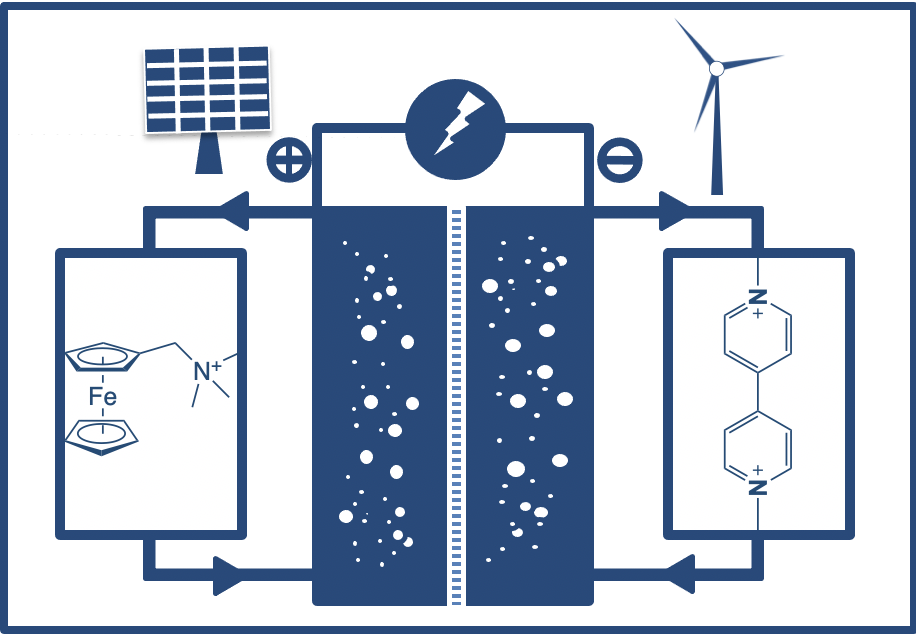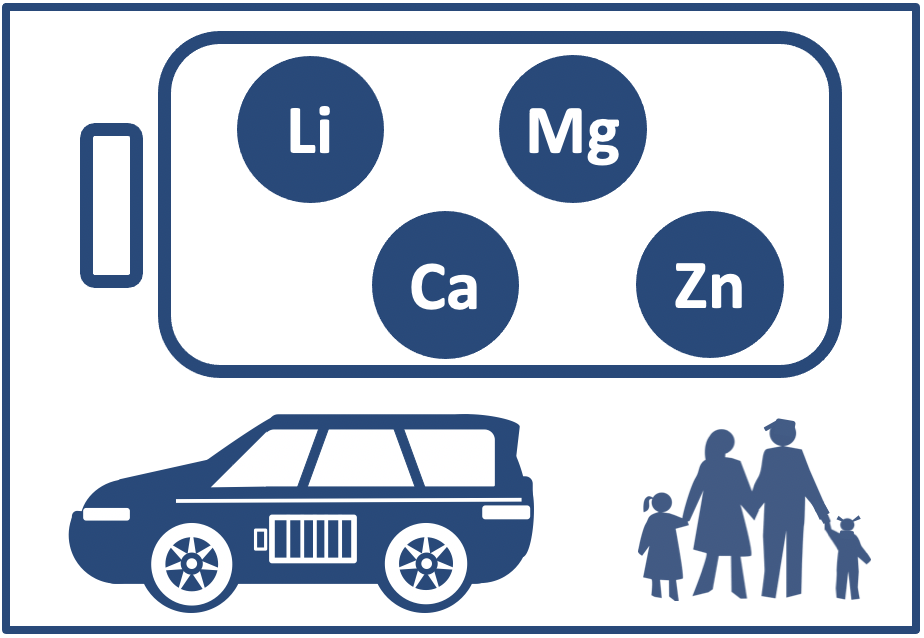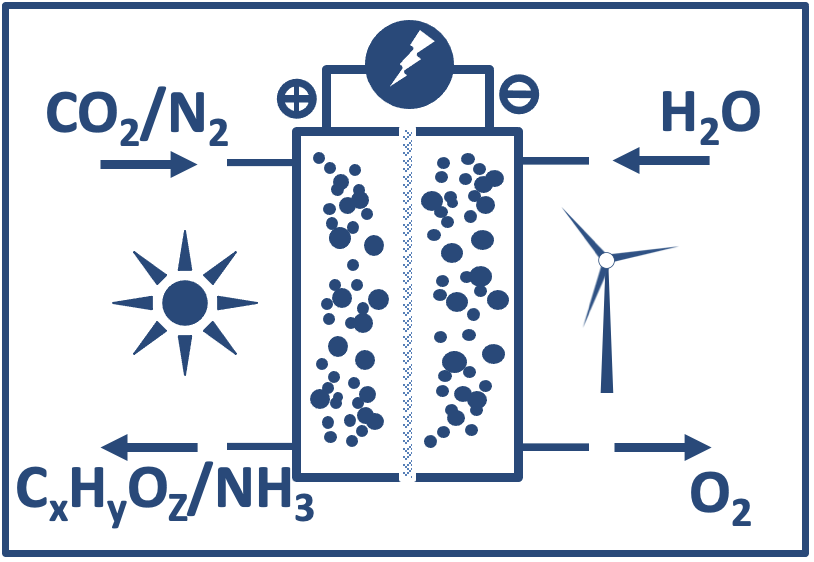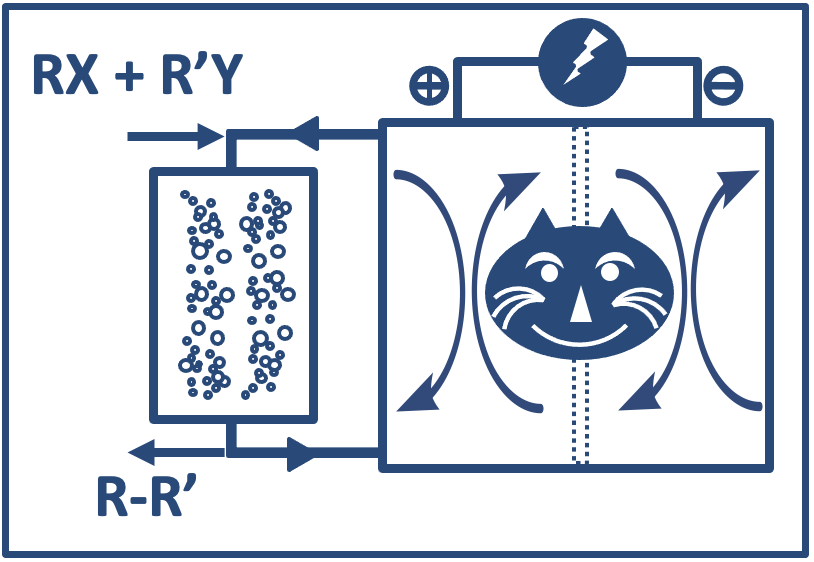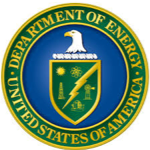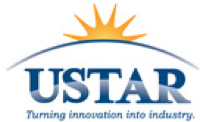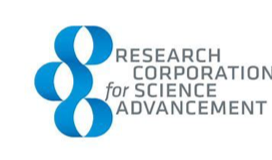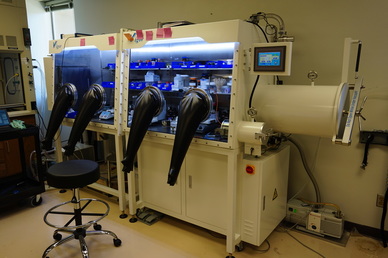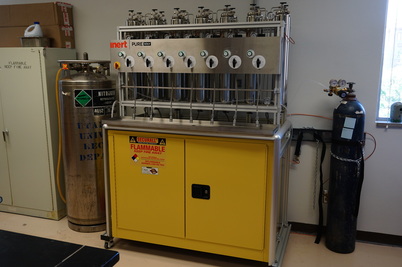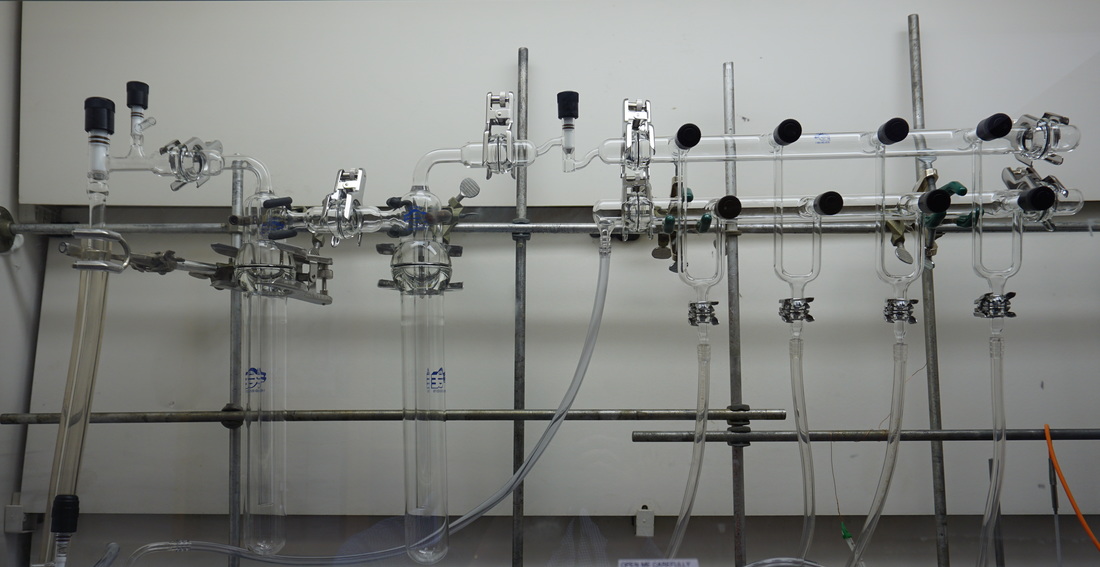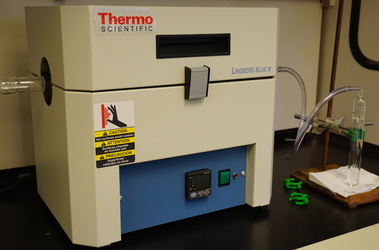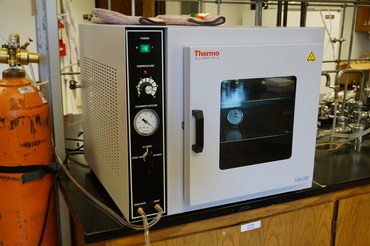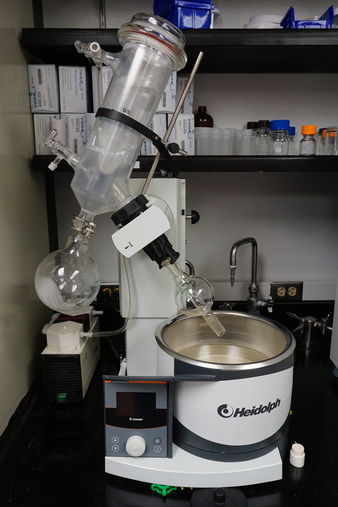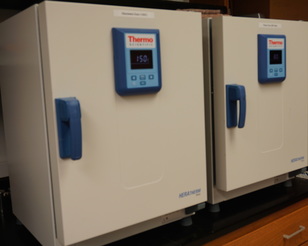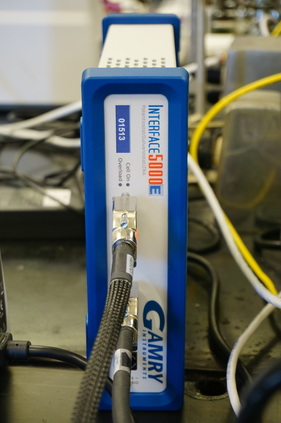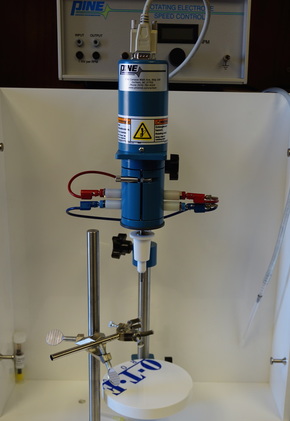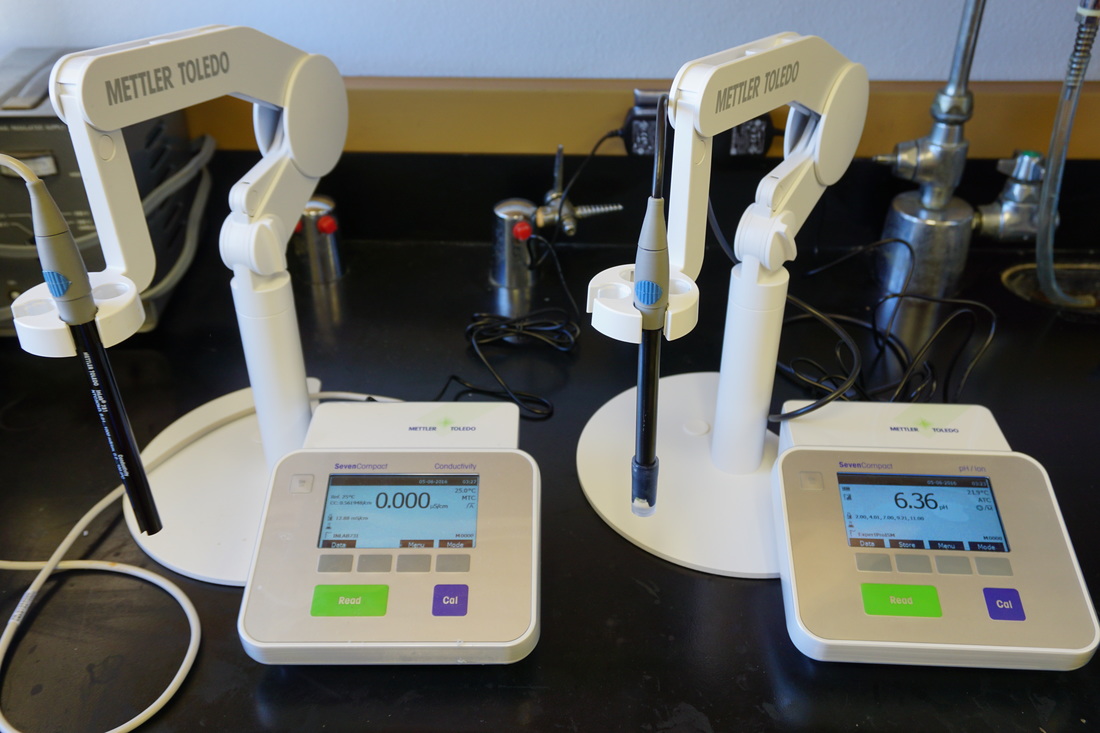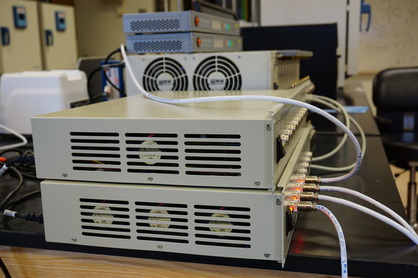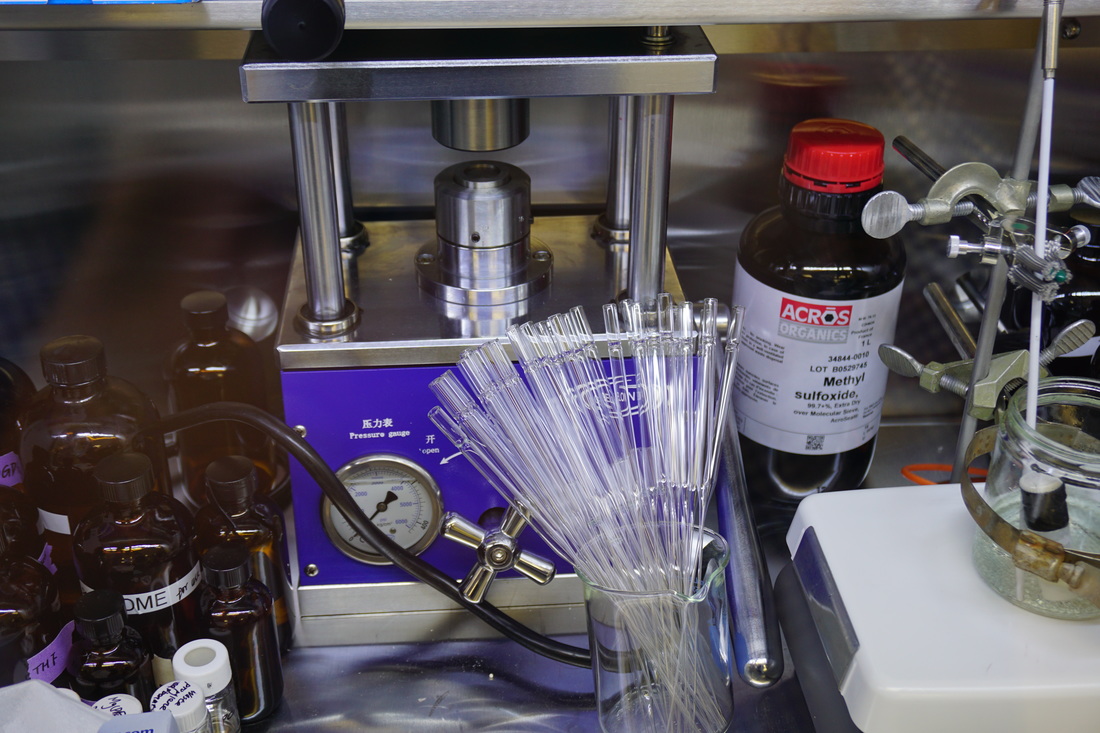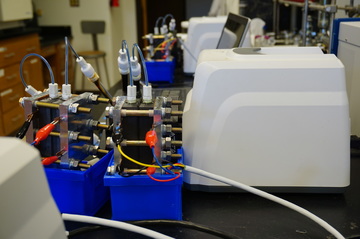Research Overview
To tackle the increasing global energy challenges, our group adopts two complementary approaches to harnessing renewable energy (e.g. solar, wind, and hydroelectric): rechargeable batteries and electrocatalysis. We also develop advanced battery technology for portable energy storage including portable devices and electrical vehicles. Furthermore, we take advantage of electrochemical potential to tackle the challenges of organic synthesis: electrosynthesis.
Our group hosts a number of state of the art experimental and analytic instruments and has access to research facilities at USU campus, USTAR Nanofabrication Center at University of Utah, and national advanced research facility. We have advanced skills and techniques to handle the synthesis and characterization of solid materials and molecules (both organic and inorganic) and development of electrochemical devices (flow batteries, fuel cells, electrolyzes, and flow e-reactors). We offer technical services and solution consultation to external users (please contact Professor Liu directly).
Please check out our synthesis and electrochemical test platforms in the Research Facility page (link).
Our group hosts a number of state of the art experimental and analytic instruments and has access to research facilities at USU campus, USTAR Nanofabrication Center at University of Utah, and national advanced research facility. We have advanced skills and techniques to handle the synthesis and characterization of solid materials and molecules (both organic and inorganic) and development of electrochemical devices (flow batteries, fuel cells, electrolyzes, and flow e-reactors). We offer technical services and solution consultation to external users (please contact Professor Liu directly).
Please check out our synthesis and electrochemical test platforms in the Research Facility page (link).
News reports on our RFB research
10/11/2019, ChemistryViews: "Better Electrolyte for Redox-Flow Batteries: pH-Neutral aqueous organic redox-flow battery with an ammonium anthraquinone anolyte" [Link]. An animated Youtube highlight prepared by www.youtube.com/watch?v=3FIRpdc1-5w 01/04/2019, China Science Daily (中国科学时报) and Sciencenet (中国科学网), “打造可再生能源后备军”. [Link] 11/13/2018, Science Magazine, "Advances in flow batteries promise cheap backup power". Science 2018, 362 (6414), 508-509." [Link] 03/19/2018, Phys.org, "Two better than one: Chemists advance sustainable battery technology". [Link] 01/04/2019, China Science Daily (中国科学时报) and Sciencenet (中国科学网), “科学家研制出高性能水相有机液流电池”. [Link] 02/08/2016, C&EN, "How Redox Flow Batteries Could Stabilize Our Electric Grids". [Link] |
Stationary Energy Storage
Redox flow batteries are regarded a promising technology for scalable and dispatchable energy storage of renewable energy, balance electrical grid, and residential and commercial energy storage. However, traditional aqueous inorganic redox flow batteries (AIRFBs) such as vanadium and Zn-bromine AIRFBs have been facing a number of material challenges such as expensive raw materials (VOSO4), paradise reactions (hydrogen and oxygen evolution, decomposition of battery components), environmental concerns using corrosive and/or toxic electrolytes (learn more about AIRFBs in our chapter, "Redox Active Inorganic Materials for Redox Flow Batteries", in EBIC) . To address these challenges, we have been developing aqueous organic redox flow batteries (AORFBs) using tunable and sustainable redox organic molecules as electrolyte materials. Specifically, we have developed pH neutral AORFBs using viologen and anthraquinone anolytes and a variety of catholytes including water-soluble ferrocene, TEMPO, ferrocyanide, halides etc. Particularly, the viologen/ferrocynide AORFB represents to be the most stable and energy dense AORFB to date. To learn more about AORFBs, please reference to our review article (ACS Energy Lett. 2019, 4, 2220-2240).
We have also developed three channel-AORFBs for desalination applications of sea water while reserving energy storage capability. Representative publications: Debruler, C.; Wu, W.; Cox, K.; Vanness, B., Liu, T. L.* "Integrated Saltwater Desalination and Energy Storage through A pH Neutral Aqueous Organic Redox Flow Battery", Adv. Func. Mater., 2020, 2000385. [Link] Luo, J.; Hu, B.; Hu, M.; Liu, T. L.* "Status and Prospects of Organic Redox Flow Batteries towards Renewable Energy Storage", ACS Energy Lett. 2019, 4, 2220-2240. [Link] Hu, B. (co-1st author); Luo, J. (co-1st author); Hu, M.; Yuan B. Liu, T. L.* "A pH Neutral, Metal Free Aqueous Organic Redox Flow Battery Employing an Ammonium Anthraquinone Anolyte", Angew. Chem. Int. Ed. 2019, 58, 16629-16636. [Link] Luo, J. (co-1st author); Hu, B. (co-1st author); DeBruler C. Zhao, Y., Yuan B. Hu, M. Wu, W. Liu, T. L.* "Unprecedented Capacity and Stability of Ammonium Ferrocyanide Catholyte in pH Neutral Aqueous Redox Flow Batteries", Joule 2019, 4, 1-15. [Link] DeBruler C.; Hu, B.; Moss, J.; Luo, J.; Liu, T. L.* "A Sulfonate Functionalized Viologen Enabling Neutral Cation Exchange Aqueous Organic Redox Flow Batteries towards Renewable Energy Storage", ACS Energy Lett. 2018, 3, 663-668. [Link] DeBruler C. (co-1st author); Hu, B. (co-1st author); Moss, J.; Liu, X. Luo, J.; Sun, Y; Liu, T. L.* "Designer Two Electron Storage Viologen Anolyte Materials for Aqueous Organic Redox Flow Batteries", Chem 2017, 3, 961-978. [Link] Luo, J.; Sam, A.; Hu, B.; DeBruler C. Liu, T. L.* "Unraveling pH Dependent Cycling Stability of Ferricyanide / Ferrocyanide in Redox Flow Batteries", Nano Energy 2017, 42, 215-221. [Link] Hu, B.; DeBruler C., Rhodes, Z.; Liu, T. L.* "Long Cycling Aqueous Organic Redox Flow Battery (AORFB) for Sustainable and Safe Energy Storage", J. Amer. Chem. Soc. 2017, 139, 1207. [Link] |
|
Portable Energy Storage
We also develop novel battery technologies beyond traditional Li ion and lead acid batteries to seek applications in portable electronic devices and electric vehicles. We primarily emphasize the development of multivalent metal batteries (Mg, Ca, and Zn) and redox flow batteries while we are also interested in discovering new technologies to advance Li ion batteries. We are particularly interested with electrolyte chemistry, electrode materials, and interfacial chemistry between electrolytes and electrode materials. Specially, we have made original contributions to the development Mg/Cl complexes electrolytes (Gen1, MAC electrolytes and Gen2, MMAC electrolytes, please read our review: ). Gen2 MMAC electrolytes have been used to develop high energy density Mg/S batteries. We have also advanced the development of Cl-free Magnesium electrolytes using ingeniously designed weakly coordinating anions, which enables the development of high voltage Mg batteries.
Leveraging our expertise in Magnesium electrolyte chemistry, we have also developed calcium electrolytes for high voltage Ca batteries. Representative publications: Bi, Y.; He, S.; Fan, C.; Luo, J.; Yuan, B.; Liu, T. L.* "A Robust Ionic Liquid Magnesium Electrolyte Enabling Mg/S Batteries", J. Mater. Chem. A 2020, 8, 12301-12305. [Link] Sun, J.; Deng, C.; Bi, Y.; Wu, K.; Zhu, S.; Xie, Z.; Li, C.; Amal, R.; Luo, L.; Liu, T. L.*; Wang, D.* "In-Situ Sulfurized Carbon-confined Cobalt for Long-Life Mg/S Batteries" ACS Appl. Energy Mater. 2020, 3, 2516–2525. [Link] Nielson, K. V.; Luo, J. Liu, T. L.* "Optimizing Calcium Electrolytes by Solvent Manipulation for Ca Batteries", Batteries & Supercaps, 2020, in press. [Link] Nielson K. V.; Liu, T. L.* "Dawn of Calcium Batteries", Angew. Chem. Int. Ed. 2020, 59, 3368-3370. [Link] Luo, J. (co-1st author); Bi, Y. (co-1st author); Zhang, L.; Zhang, X.; Liu, T. L.* "A Stable, Non-corrosive Perfluorinated Pinacolatoborate Mg Electrolyte for Rechargeable Mg Batteries", Angew. Chem. Int. Ed. 2019, 58, 6967-6971. [Link] Luo, J; .He, S.; Liu, T. L.* "Ternary Mg/MgCl2/AlCl3 Inorganic Mg2+ Electrolytes with Unprecedented Electrochemical Performance for Reversible Mg Deposition", ACS Energy Letters 2017, 2, 1197-1202. [Link] Liu, T.*; Shao, Y.; Li, G.; Gu, M.; Hu, J.; Xu, S.; Nie, Z.; Chen, X.; Wang, C.; Liu, J. “A facile approach using MgCl2 to formulate high performance Mg2+ electrolytes for rechargeable Mg batteries”, J. Mater. Chem. A 2014, 2, 3430-3438. [Link] |
|
Energy Electrocatalysis
The electrocatalysis program encompasses synthesis and electrochemical studies of bio-inspired (e.g. nitrogenase, CO-dehydrogenase, and hydrogenase) molecular catalysts and hybrid organic/inorganic nano-catalysts for chemical fuel production (H2, CO, alcohols, and ammonia) using earth abundant materials (H2O, CO2, and N2) and renewable energy sources, and also electrochemical consumption of chemical fuels. At the fundamental level, we want to manage multi-proton-multi-electron transfers to facilitate catalytic energy conversion at optimal rate and energy efficiency. Additionally, we are extremely enthusiastic in fabricating energy device prototypes (electrolyzers and fuel cells) for technical implementation.
|
|
Green Electrosynthesis
This theme is directed on the development of well-defined molecular catalysts based on inexpensive metals (e.g. Mn, Fe, Ni, Co, W, Mo) to handle homogenous catalysis that is traditionally achieved by precious metal (e.g. Rh, Ir, and Pd) based catalysts. To realize “base metals for noble tasks”, we pay particular attention to ligand design and take fully advantage of the ligand second coordination sphere effect and the metal-ligand cooperation effect for highly efficient bond activation and formation, and their uses in catalytic synthesis of valuable organic products.
|
Our Sponsors
Our research have been generously sponsored by federal and state funding agencies, and non-profit foundations listed below. We appreciate your support very much!
|
Multifunctional glovebox (1 for non-aqueous and 1 for aqueous)
|
Automatic solvent purification system:
|
|
Vacuum oven:
Rotovap (3 units):
|
Drying oven (5 units):
Temperature controller
|
Electrochemical Testing Platform
|
Multifunctional potentiostats (5 units):
|
Rotation electrode controller
|
|
Conductivity meter and pH meter
Multi-channel battery testers (12 units, 96 channels):
|
Coin cell crimper:
Home design redox flow battery platform:
|

